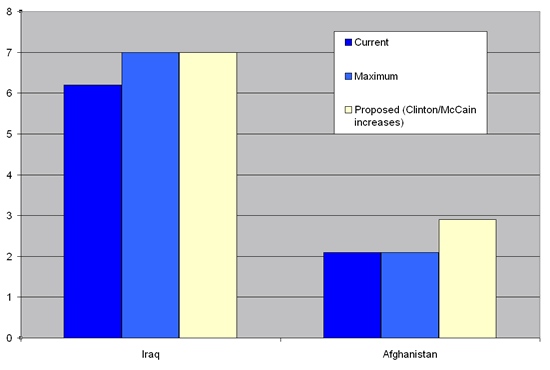November 15, 2006
Ralph Peters: an 'I was wrong' would be nice
The increasingly unhinged Ralph Peters, today:
With political correctness permeating our government and even the upper echelons of the military, we never tried the one technique that has a solid track record of defeating insurgents if applied consistently: the rigorous imposition of public order.
Peters, eight months ago:
In place of the civil war that elements in our media declared, I saw full streets, open shops, traffic jams, donkey carts, Muslim holiday flags - and children everywhere, waving as our Humvees passed. Even the clouds of dust we stirred up didn't deter them. And the presence of children in the streets is the best possible indicator of a low threat level.
Troop numbers in Afghanistan v Iraq: are different prescriptions required?
A reader of the last few posts could ask why a proposal by Bill Clinton to increase Afghan force levels by 8,000 meets with some approval and a proposed increase by John McCain of Iraq force levels by 20,000 does not.
Leaving aside all the other obvious differences between the situations in the two nations, an argument for this view can still be made solely for statistical reasons. Simply put, the McCain proposal is repeating something that's already been tried, whereas the Clinton proposal is breaking new ground.
In Iraq, coalition forces there are at pretty much their historic average for troop numbers in country: 161,000. The McCain proposal to increase this by 20,000 only brings the number back to the 183,000 peak it's already been at twice before, with no apparent lasting impact on violence levels nation-wide. (The old line about insanity being doing the same exact thing and expecting different results may be worth considering in this context.)
In Afghanistan, NATO force levels, now slightly above 30,000, are at their historic high. There have never been as many Western troops dedicated to the Afghan problem as there have been since early this fall. Clinton's proposal is, that in light of recent developments that indicate trouble ahead in the southern and eastern NATO regional command areas in 2007, that this number should be increased even further, up as much as 40,000.
Also worth noting in this context is that troop levels, compared to the size of the population, are significantly lower in Afghanistan than in Iraq. Iraq-style troop levels, or anything remotely close to them, have never been tried in Afghanistan until now. Even the Clinton proposal would only bring troop densities up to 3 coalition soldiers per 1000 inhabitants... still less than half of the Iraq average (see graph below):
Coalition soldiers per 1000 inhabitants
The argument of the numbers indicates that, in the absence of other changes in doctrine and strategy, another 20,000 soldiers in Iraq is unlikely to accomplish anything previous similarly-sized attempts already have. To really put the thesis that troop levels are the main issue in these occupation efforts to the test, one would have to increase the number of American soldiers on the ground in Iraq by a much larger number, perhaps as many as the 50,000 advocated by William Kristol here, for something in excess of six months.
There are obvious questions about whether the United States has the force generation capacity to do this any time soon. Certainly, any significant increase in Iraq troop levels will rule out Clinton's recommended increase for Afghanistan. It's something of an either-or between reinforcing the two occupation efforts as much as proponents of either course have proposed.
This is a pity, because if the logic of those calling for troop level increases in Iraq has any validity, it will have even more validity in Afghanistan, where for a much smaller commitment of troops, one could potentially "flood the zone" with occupiers more effectively than one could ever do in Iraq. It's even possible that one extra reinforced brigade in Afghanistan next year would have as much influence on that country as committing two new divisions would in Iraq... even if those divisions existed to send. The risk here is, that by undermanning Afghanistan in 2007, one could end up significantly degrading the security situation in that country without having any significant offsetting influence in Iraq.
This is the same risk that is warned against, in the context of a single-country insurgency, by Andrew Krepinevich with his writings on an "inkblot strategy:" address the problem insufficiently on a country-wide basis, and you will lose all to the insurgents: focus on one province, or one city, and work out, and you have a better chance to succeed. It may be possible that policy makers in the U.S. and NATO should start envisioning Iraq-Afghanistan as a combined problem, where Afghanistan is currently the best location in the theatre for future inkblotting.
"endearingly macho" -- Mark Steyn
"wonderfully detailed analysis" -- John Allemang, Globe and Mail
"unusually candid" -- Tom Ricks, Foreignpolicy.com
May 2010
April 2010
March 2010
February 2010
January 2010
December 2009
November 2009
October 2009
September 2009
August 2009
July 2009
News:
The Globe and Mail
The Star
The Wash. Post
Opinion:
TNR
Slate
Washington Monthly
Rants:
Canadians
Penny
Janes
Cosh
The Hound
Coyne
Wells
Farrell, etc.
Steyn
Levant
Afghanistan
The Torch
Abu M.
Bill & Bob
Ghosts of Alex
Registan
Jari
Ink Spots
Ackerman
Kings
FRI
Embedded
Milnews.ca
Can-AFG
The Capt.
Etc.
TMLutas
Sullivan
Marshall
Kaus
Lileks
Reynolds
Welch
Farber
The Shark
Breen
Henley
Electrolite
Samizdata
Slotman
Simberg
Northrup
Bryant
Yglesias
Cole
Drum
Clients/Employers
(Past and Present):
U of T
Cdn. Forces
CG Magazine
LRC
Adrenaline Vault
